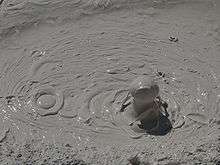Bubble (physics)





A bubble is a globule of one substance in another, usually gas in a liquid. Due to the Marangoni effect, bubbles may remain intact when they reach the surface of the immersive substance.
Common examples
Bubbles are seen in many places in everyday life, for example:
- As spontaneous nucleation of supersaturated carbon dioxide in soft drinks
- As water vapor in boiling water
- As air mixed into agitated water, such as below a waterfall
- As sea foam
- As a soap bubble
- As given off in chemical reactions, e.g., baking soda + vinegar
- As a gas trapped in glass during its manufacture
- An air bubble in a solution of fluorescein and water (or alcohol) is the essential part of a spirit level
Physics and chemistry
Bubbles form, and coalesce, into globular shapes, because those shapes are at a lower energy state. For the physics and chemistry behind it, see nucleation.
Appearance
Humans can see bubbles because they have a different refractive index (IR) than the surrounding substance. For example, the IR of air is approximately 1.0003 and the IR of water is approximately 1.333. Snell's Law describes how electromagnetic waves change direction at the interface between two mediums with different IR; thus bubbles can be identified from the accompanying refraction and internal reflection even though both the immersed and immersing mediums are transparent.
The above explanation only holds for bubbles of one medium submerged in another medium (e.g. bubbles of gas in a soft drink); the volume of a membrane bubble (e.g. soap bubble) will not distort light very much, and one can only see a membrane bubble due to thin-film diffraction and reflection.
Applications
Nucleation can be intentionally induced, for example to create bubblegram.
In medical ultrasound imaging, small encapsulated bubbles called contrast agent are used to enhance the contrast.
In thermal inkjet printing, vapor bubbles are used as actuators. They are occasionally used in other microfluidics applications as actuators.[1]
The violent collapse of bubbles (cavitation) near solid surfaces and the resulting impinging jet constitute the mechanism used in ultrasonic cleaning. The same effect, but on a larger scale, is used in focused energy weapons such as the bazooka and the torpedo. Pistol shrimp also use a collapsing cavitation bubble as a weapon. The same effect is used to treat kidney stones in a lithotripter. Marine mammals such as dolphins and whales use bubbles for entertainment or as hunting tools. Aerators cause dissolution of gas in the liquid by injecting bubbles.
Chemical and metallurgic engineers rely on bubbles for operations such as distillation, absorption, flotation and spray drying. The complex processes involved often require consideration for mass and heat transfer, and are modelled using fluid dynamics.[2]
The star-nosed mole and the American water shrew can smell underwater by rapidly breathing through their nostrils and creating a bubble. [3]
Pulsation
When bubbles are disturbed, they pulsate (that is, they oscillate in size) at their natural frequency. Large bubbles (negligible surface tension and thermal conductivity) undergo adiabatic pulsations, which means that no heat is transferred either from the liquid to the gas or vice versa. The natural frequency of such bubbles is determined by the equation:[4][5]
where:
- is the specific heat ratio of the gas
- is the steady state radius
- is the steady state pressure
- is the mass density of the surrounding liquid
Smaller bubbles undergo isothermal pulsations. The corresponding equation for small bubbles of surface tension σ (and negligible liquid viscosity) is[5]
Excited bubbles trapped underwater are the major source of liquid sounds, such as when a rain droplet impacts a surface of water.[6][7]
Physiology and medicine
Injury by bubble formation and growth in body tissues is the mechanism of decompression sickness, which occurs when supersaturated dissolved inert gases leave solution as bubbles during decompression. The damage can be due to mechanical deformation of tissues due to bubble growth in situ, or by blocking blood vessels where the bubble has lodged.
Arterial gas embolism can occur when a gas bubble is introduced to the circulatory system and it lodges in a blood vessel which is too small for it to pass through under the available pressure difference. This can occur as a result of decompression after hyperbaric exposure, a lung overexpansion injury, during intravenous fluid administration, or during surgery.
See also
| Wikimedia Commons has media related to Bubbles. |
References
- ↑ R. J. Dijkink, J. P. van der Dennen, C. D. Ohl, A. Prosperetti,The ‘acoustic scallop’: a bubble-powered actuator, J. Micromech. Microeng. 16 1653 (2006)
- ↑ Weber; et al. (1978). Bubbles, Drops and Particles. New York: Dover Publications. ISBN 0-486-44580-1.
- ↑ Roxanne Khamsi. "Star-nosed mole can sniff underwater, videos reveal".
- ↑ Minnaert, Marcel, On musical air-bubbles and the sounds of running water, Phil. Mag. 16, 235-248 (1933).
- 1 2 Leighton, Timothy G., The Acoustic Bubble (Academic, London, 1994).
- ↑ Prosperetti, Andrea; Oguz, Hasan N. (1993). "The impact of drops on liquid surfaces and the underwater noise of rain" (PDF). Annual Review of Fluid Mechanics. 25: 577–602. Bibcode:1993AnRFM..25..577P. doi:10.1146/annurev.fl.25.010193.003045. Retrieved 2006-12-09.
- ↑ Rankin, Ryan C. (June 2005). "Bubble Resonance". The Physics of Bubbles, Antibubbles, and all That. Retrieved 2006-12-09.
External links
- Bubble physics – touches on vapor pressure, bubble formation, bubble dynamics, cavitation, acoustic oscillations, sound of raindrops underwater, Rayleigh-Plesset equation, snapping shrimp, lithotripsy, ultrasonic cleaning, sonochemistry, sonoluminescence, medical reperfusion imaging, and micro-bubble therapy